- Home
- Richard Dawkins
The Greatest Show on Earth Page 33
The Greatest Show on Earth Read online
Page 33
Not all neutral mutations are quite so neutral as that. Sometimes the new gene translates into a different protein, but the ‘active site’ (remember the carefully shaped ‘dents’ that we met in Chapter 8) of the new protein remains the same as the old one. Consequently, there is literally no effect on the embryonic development of the body. The unmutated and the mutated form of the gene are still synonyms as far as their effects on bodies are concerned. It is also possible (although ‘ultra-Darwinists’ like me incline against the idea) that some mutations really do change the body, but in such a way as to have no effect on survival, one way or the other.
So, to sum up on the neutral theory, to say that a gene, or a mutation, is ‘neutral’ doesn’t necessarily mean that the gene itself is useless. It could be vitally important to the animal’s survival. What it means is that the mutated form of a gene – which might or might not be important for survival – is no different from the unmutated form with respect to its effects (which might be very important) on survival. As it happens, it is probably true to say that most mutations are neutral. They are undetectable by natural selection, but detectable by molecular geneticists; and that is an ideal combination for an evolutionary clock.
None of this is to downgrade the all-important tip of the iceberg – the minority of mutations that are not neutral. It is they that are selected, positively or negatively, in the evolution of improvements. They are the ones whose effects we actually see – and natural selection ‘sees’ too. They are the ones whose selection gives living things their breathtaking illusion of design. But it is the rest of the iceberg – the neutral mutations, which are in the majority – that concern us when we are talking about the molecular clock.
As geological time goes by, the genome is subjected to a rain of attrition in the form of mutations. In that small portion of the genome where the mutations really matter for survival, natural selection soon gets rid of the bad ones and favours the good ones. The neutral mutations, on the other hand, simply pile up, unpunished and unnoticed – except by molecular geneticists. And now we need a new technical term: fixation. A new mutation, if it is genuinely new, will have a low frequency in the gene pool. If you revisit the gene pool a million years later, it is possible that the mutation will have increased in frequency to 100 per cent or something close to it. If that happens, the mutation is said to have ‘gone to fixation’. We shall no longer think of it as a mutation. It has become the norm. The obvious way for a mutation to go to fixation is for natural selection to favour it. But there is another way. It can go to fixation by chance. Just as a once proud surname can die out for lack of male heirs, so the alternatives to the mutation we are talking about can just happen to disappear from the gene pool. The mutation itself can become frequent in the gene pool, by the same luck as has led ‘Smith’ to emerge as the commonest surname in England. Of course it is much more interesting if the gene goes to fixation for a good reason – that’s natural selection – but it can also happen by chance, given a large enough number of generations. And geological time is vast enough for neutral mutations to go to fixation at a predictable rate. The rate at which they do so varies, but it is characteristic of particular genes, and, given that most mutations are neutral, this is precisely what makes the molecular clock possible.
It’s fixation that matters for the molecular clock, because ‘fixed’ genes are the ones that we look at when we compare two modern animals to try to estimate how long ago their ancestors split apart. Fixed genes are the genes that characterize a species. They are the ones that are all but universal in the gene pool. And we can compare the genes that have become fixed in one species with the genes that have become fixed in another, in order to estimate how recently the two species split apart. There are complications, which I won’t go into because Yan Wong and I discussed them fully in ‘The Epilogue to the Velvet Worm’s Tale’. With reservations, and with various important correction factors, the molecular clock works.
Just as radioactive clocks tick at hugely variable speeds, with half-lives ranging from fractions of a second through to tens of billions of years, so different genes provide a marvellous spread of molecular clocks, suitable for timing evolutionary change on scales ranging from a million to a billion years, and all stages in between. Just as each radioactive isotope has its characteristic half-life, so each gene has a characteristic turnover rate – the rate at which new mutations typically go to fixation by random chance. Histone genes characteristically turn over at a rate of one mutation per billion years. Fibrinopeptide genes are a thousand times faster, with a turnover of one new mutation fixed per million years. Cytochrome-C and the suite of haemoglobin genes have intermediate turnovers, with times to fixation measured in millions to tens of millions of years.
Neither radioactive clocks nor molecular clocks tick in a regular fashion like a pendulum clock or a watch. If you could hear them ticking, they’d sound like a Geiger counter, the radioactive clocks literally so since a Geiger counter is precisely what you would use to listen to them. A Geiger counter doesn’t tick regularly, like a watch; it ticks at random, the ticks coming in strange, stuttering bursts. That’s how mutations, and fixations, would sound, if we could hear them on the immensely long timescale of geology. But, whether stuttering like a Geiger counter or ticking metronomically like a watch, the important thing about a timekeeper is that it should tick at a known average rate. That’s what radioactive clocks do, and that’s what molecular clocks do.
I introduced the molecular clock by saying that it assumes the fact of evolution and therefore can’t be used in evidence of it. But now, having understood how the clock works, we can see that I was too pessimistic. The very existence of pseudogenes – useless, untranscribed genes that bear a marked resemblance to useful genes – is a perfect example of the way animals and plants have their history written all over them. But that is a topic that must wait for the next chapter.
* You may be surprised to hear that horses evolved in North America, because it is widely known that when the European invaders first came to the Americas, the sight of them on horseback amazed the natives. The bulk of horse evolution did indeed take place in America. Then horses spread to the rest of the world, shortly (by geological standards) before going extinct in America. They are American animals that have been re-introduced to America by man.
* A single bone in mammals. The reptilian lower jaw is more complicated – and thereby hangs a fascinating tale that I reluctantly omitted from this book (you can’t have everything). In an amazing feat of evolutionary legerdemain, the smaller bones of the reptilian lower jaw were coopted into the mammalian ear, where they constitute an exquisitely delicate bridge, to transport sound from the eardrum to the inner ear.
* The Dutch ‘wildebeest’ is increasingly used in preference to ‘gnu’. I am trying to save ‘gnu’ because, if it dies out altogether, the witty song by Flanders and Swann won’t make sense any more. (‘Gnor am I in the least / Like that dreadful hartebeest / Oh gno gno gno, I’m a gnu!’)
* I presume my readers know better than the author(s) of Leviticus, who thought that bats were birds. In chapter 11, verses 13–19, is a long list of birds that are an abomination, beginning with the eagle and ending with ‘the stork, the heron after her kind, and the lapwing, and the bat’. It is a separate question why it was necessary to condemn any animals as abominations. It was a common practice in many religions.
* Biologists used to cite plant haemoglobin as a possible example of DNA borrowing by plants from the animal kingdom. Plants of the pea family (Leguminosae) have on their roots ‘nodules’, in which dwell bacteria that capture nitrogen from the atmosphere and make it available to the plants. This is why farmers often include a leguminous crop, such as clover or a vetch, in their rotation. It puts valuable nitrogen in the soil, especially if the clover crop is ploughed under. The nodules are a reddish colour because they contain a form of haemoglobin, similar to the oxygen-transporting molecule that makes our blood red. The gen
es for making haemoglobin are in the plant genome, not the bacterial genome. Haemoglobin is important to the bacteria, which need oxygen, and it can be regarded as part of the deal between bacteria and plants: the bacteria give the plants usable nitrogen, while the plants give the bacteria a house, and usable oxygen delivered via haemoglobin. Since we are accustomed to associating haemoglobin with blood, it was natural to wonder whether a gene for making it had somehow been ‘borrowed’ from an animal genome, perhaps ferried by a bacterium. It would, indeed, have been a very valuable idea to ‘borrow’. Unfortunately for this appealing idea – the ultimate blood transfusion – molecular biological evidence shows that haemoglobins are ancient denizens of plant genomes. They are not borrowed. They have been there from ancient times.
* It is a little-known fact that some dinosaurs had a ganglion in the pelvis, which was so large (at least relative to the brain in the head) as almost to deserve the title of second brain. This prompted the following delightfully witty verse by the American comic writer Bert Leston Taylor (1866–1921):
Behold the mighty dinosaur,
Famous in prehistoric lore,
Not only for his power and strength
But for his intellectual length.
You will observe by these remains
The creature had two sets of brains –
One in his head (the usual place),
The other at his spinal base,
Thus he could reason A priori
As well as A posteriori.
No problem bothered him a bit
He made both head and tail of it.
So wise was he, so wise and solemn,
Each thought filled just a spinal column.
If one brain found the pressure strong
It passed a few ideas along.
If something slipped his forward mind
’Twas rescued by the one behind.
And if in error he was caught
He had a saving afterthought.
As he thought twice before he spoke
He had no judgment to revoke.
Thus he could think without congestion
Upon both sides of every question.
Oh, gaze upon this model beast,
Defunct ten million years at least.
* D’Arcy Thompson was surely one of the most erudite scientists ever. Not only did he write famously beautiful English of a patrician character, not only was he a published mathematician and classical scholar as well as Professor of Natural History at Scotland’s oldest university, but his book is laced with quotations, which he assumed he had no need to translate (how times have changed), in Latin, Greek, Italian, German, French and even Provençal (the last he did deign to translate – into French!).
* Strictly speaking, two shapes are homeomorphic if you can distort one to become the other without breaking it, and without any new touchings.
* Perhaps ‘all living creatures’ calls for a note of caution. In an earlier section of this chapter we saw that while the principle of ‘No borrowing’ is almost completely appropriate for animals and plants, bacteria are different. Among bacteria (and archaea, which are superficially like bacteria but rather distantly related) there is plenty of sharing of genes. Whereas animals use sexual coupling to exchange DNA within species, bacteria use their own form of ‘Copy and Paste’ to pass DNA around, even between distantly related species. Although I was right to extol the ‘one true tree of life’ for animals and plants, the whole business gets messier when we turn to microorganisms. As my colleague the philosopher Dan Dennett has put it, where the tree of life for animals is a majestically spreading oak, that for bacteria is more like a banyan. Where bacteria are concerned, there is something to be said for compiling a ‘one true tree’ for each gene separately, regardless of which particular kinds of bacteria it happens to be travelling around in. What a fascinating prospect. How Darwin would have loved it.
* When I first read Calculus Made Easy by Silvanus P. Thompson, on the recommendation of my engineer grandfather, it gave me goosebumps when Thompson introduced e in italics as ‘a number never to be forgotten’. One consequence of using e rather than, say, 2, as the factor of choice, is that you can calculate the darwins directly by subtracting natural logarithms from one another. Other scientists have proposed, as a unit of evolutionary rate, the haldane.
* I have even been called an ‘ultra-Darwinist’, a gibe that I find less insulting than its coiners perhaps intended.
* ‘Degenerate’ is not the same (though the two terms are often confused) as ‘redundant’, another technical term of Information Theory. A redundant code is one in which the same message is conveyed more than once (e.g. ‘She is a female woman’ conveys the message of her sex three times). Redundancy is used by engineers to guard against transmission errors. A degenerate code is one in which more than one ‘word’ is used to mean the same thing. In the genetic code, for example, CUC and CUG both spell ‘Leucine’: a mutation from CUC to CUG therefore makes no difference. That’s ‘degenerate’.
CHAPTER 11
HISTORY WRITTEN ALL OVER US
I BEGAN this book by imagining a teacher of Latin forced to waste time and energy defending the proposition that the Romans and their language ever existed. Let’s return to that thought, and ask what actually is the evidence for the Roman Empire and the Latin language. I live in Britain where, as in the rest of Europe, Rome wrote her signature all over the map, carved her ways into the landscape, wove her language through ours and her history through our literature. Walk the length of Hadrian’s Wall, whose preferred local name is still ‘The Roman Wall’. Walk, as I walked Sunday after Sunday in crocodile formation from my boarding school in (relatively) new Salisbury, to the Roman flint fort of Old Sarum, and commune with the imagined ghosts of dead legions. Unfold an Ordnance Survey map of England. Wherever you see a long, dead straight country road, especially when there are green field gaps between stretches of road or cart track that you can exactly line up with a ruler, you’ll almost always find a Roman label beside it. Vestiges of the Roman Empire are all around us.
Living bodies, too, have their history written all over them. They bristle with the biological equivalent of Roman roads, walls, monuments, potsherds, even ancient inscriptions carved into the living DNA, ready to be deciphered by scholars.
Bristle? Yes, literally. When you are cold, or badly frightened, or haunted by the peerless craftsmanship of a Shakespeare sonnet, you get goosebumps. Why? Because your ancestors were normal mammals with hairs all over, and these were raised or lowered at the behest of sensitive bodily thermostats. Too cold, and the hairs were erected to plump up the layer of insulating trapped air. Too warm, and the coat was flattened to allow body heat to escape more easily. In later evolution, the hair-erection system was hijacked for social communication purposes, and became involved in The Expression of the Emotions, as Darwin was one of the first to appreciate in his book of that name. I can’t resist sharing with you some lines – vintage Darwin – from that book:
Mr Sutton, the intelligent keeper in the Zoological Gardens, carefully observed for me the Chimpanzee and Orang; and he states that when they are suddenly frightened, as by a thunderstorm, or when they are made angry, as by being teased, their hair becomes erect. I saw a chimpanzee who was alarmed at the sight of a black coalheaver, and the hair rose all over his body . . . I took a stuffed snake into the monkey-house, and the hair on several of the species instantly became erect . . . When I showed a stuffed snake to a Peccary, the hair rose in a wonderful manner along its back; and so it does with a wild boar when enraged.
The hackles are raised in anger. In fear also, hairs stand on end to increase the body’s apparent size and scare off dangerous rivals or predators. Even we naked apes still have the machinery to raise non-existent (or barely-existent) hairs, and we call it goosebumps. The hair-erection machinery is a vestige, a non-functional relic of something that did a useful job in our long-dead ancestors. Vestigial hairs are among the many insta
nces of history written all over us. They constitute persuasive evidence that evolution has occurred, and again it comes not from fossils but from modern animals.
As we saw in the previous chapter, where I compared it to a comparably sized fish such as a dorado, you don’t have to dig very deep inside a dolphin to uncover its history of life on dry land. Despite its streamlined, fish-like exterior, and despite the fact that it now makes its entire living in the sea and would soon die if beached, a dolphin, but not a dorado, has ‘land mammal’ woven through its very warp and woof. It has lungs not gills, and will drown like any land animal if prevented from coming up for air, although it can hold its breath for much longer than a land mammal. In all sorts of ways, its air-breathing apparatus is changed to fit its watery world. Instead of breathing through two little nostrils at the end of its nose like any normal land mammal, it has a single nostril in the top of its head, which enables it to breathe while only just breaking the surface. This ‘blowhole’ has a tight-sealing valve to keep water out, and a wide bore to minimize the time needed for breathing. In an 1845 communication to the Royal Society, which Darwin, as a Fellow, would quite likely have read, Francis Sibson Esq.* wrote: ‘The muscles that open and close the blow-hole, and that act upon the various sacs, form one of the most complicated yet most exquisitely adjusted pieces of machinery that either nature or art presents.’ The dolphin’s blowhole goes to great lengths to correct a problem that would never have arisen at all if only it breathed with gills, like a fish. And many of the details of the blowhole can be seen as corrections to secondary problems that arose when the air intake migrated from the nostrils to the top of the head. A real designer would have planned it in the top of the head in the first place – that’s if he hadn’t decided to abolish lungs and go for gills anyway. Throughout this chapter, we shall continually find examples of evolution correcting an initial ‘mistake’ or historical relic by post hoc compensation or tweaking, rather than by going back to the drawing board as a real designer would. In any case, the elaborate and complex gateway to the blowhole is eloquent testimony to the dolphin’s remote ancestry on dry land.

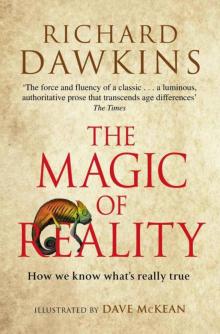 The Magic of Reality
The Magic of Reality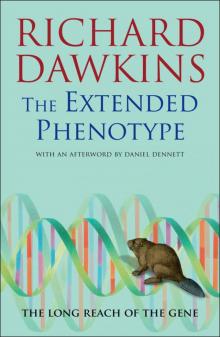 The Extended Phenotype
The Extended Phenotype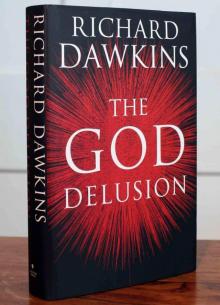 The God Delusion
The God Delusion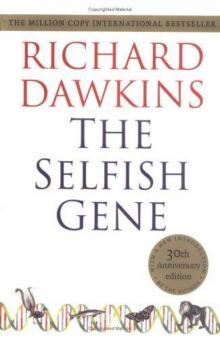 The Selfish Gene
The Selfish Gene The Blind Watchmaker
The Blind Watchmaker The Greatest Show on Earth
The Greatest Show on Earth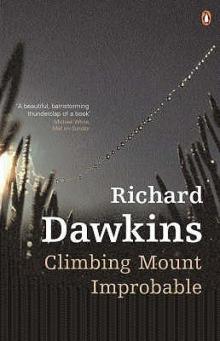 Climbing Mount Improbable
Climbing Mount Improbable Outgrowing God
Outgrowing God Brief Candle in the Dark
Brief Candle in the Dark The Greatest Show on Earth: The Evidence for Evolution
The Greatest Show on Earth: The Evidence for Evolution Science in the Soul
Science in the Soul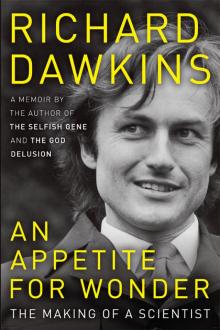 An Appetite for Wonder
An Appetite for Wonder